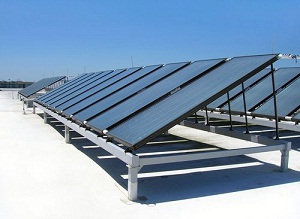Solar hot water used to treat dialysis patients
 DaVita Inc. is piloting the use of a solar-hot water installation in Scottsburg, Ind., to pre-heat water used in dialysis. Though using sun to heat water isn’t by any means a first, it’s the first such application of using the sun to treat kidney-failure diseases.
DaVita Inc. is piloting the use of a solar-hot water installation in Scottsburg, Ind., to pre-heat water used in dialysis. Though using sun to heat water isn’t by any means a first, it’s the first such application of using the sun to treat kidney-failure diseases.
The company undertook the pilot and installed solar thermal panels in an attempt to reduce its use of natural-gas-generated hot water at the site.
DaVita is a nationwide provider of kidney care services, and among its services is filtering blood for patients through the dialysis process. The process uses significant amounts of water preheated to match the temperature of the human body.
“In the dialysis process, the system goes through four filtrations,” said Megan Bloomer, DaVita’s director of sustainability. She added that the process is very regulated with alarms throughout the filtration stages to make sure that the water is properly conditioned.
The solar-thermal array was installed at the Scottsburg facility in 2010. After roughly a year of service, the company reported that the array reduced the amount of natural gas it used to heat water at the facility by 75 percent.
“My understanding is we’re getting within 10- to 20-degrees with what we need that temperature to be,” Bloomer said.
The company is looking into other sustainable technologies as well, according to Bloomer.
Though it leases rather than owns the buildings it works out of, DaVita is looking into using solar at more locations.
“Obviously. in the dialysis clinics, it makes sense to look at solar-hot water, and at our business offices it makes more sense to do photovoltaics there,” she said.
It is looking to install photovoltaics on four of its office buildings through power-purchase agreements. It’s also looking into installing a microhydro turbine system at a clinic in San Francisco. The company discharges water at a rate of seven to eight gallons a minute at its clinic, making microhydro another possibility for the company.
“We are constantly investigating new technology in many given areas across the country,” she said.
In this case, they chose the location for the pilot because it was close to a similar clinic nearby.
“It’s a good location. We have a similar-sized clinic about 45 minutes down the road. We always want to use comparative clinics for our pilots,” she said.
Image courtesy of NREL.



